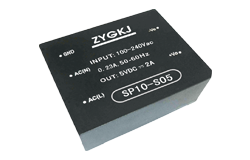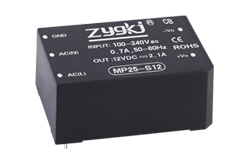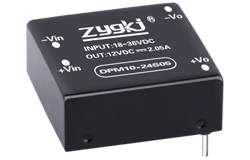noticias
Creación de un convertidor CA-CC: una guía para convertir corriente alterna en corriente continua
Autor: Módulo de potencia ZYG Time: 2023-4-12
If you work with electronics, you may find yourself needing to convert AC (alternating current) to DC (direct current) at some point. This can be done with a simple AC-DC converter circuit. In this guide, we walk you through the process of creating your own converter circuit.
First things first, let\ explain the difference between AC and DC. Alternating current is the kind of electricity that comes out of your wall socket. It oscillates back and forth, changing direction 50 or 60 times per second. Direct current, on the other hand, flows in one direction only. Most electronic devices require DC to function.
To create an AC-DC converter, you need a few basic components. These include a transformer, a diode bridge, and some capacitors. Let take a closer look at each of these.
The transformer is the first component in the circuit. Its job is to step down the voltage of the AC input to a lower level that can be handled by the diode bridge. The transformer consists of two coils of wire wound around an iron core. The input AC voltage is applied to one coil, while the output DC voltage is taken from the other coil.

The diode bridge is the second component in the circuit. It consists of four diodes arranged in a bridge configuration. The diodes allow current to flow in only one direction, effectively converting the AC input to DC output.
The capacitors are the final components in the circuit. They work to smooth out the DC output, removing any remaining AC ripple. Two capacitors are used in the circuit: a large electrolytic capacitor and a smaller ceramic capacitor.
Now that we understand the components, let take a look at the circuit diagram.
As you can see, the transformer is connected to the AC input, while the diode bridge and capacitors are connected to the DC output. The large electrolytic capacitor is connected in parallel to the DC output to smooth out the output voltage. The smaller ceramic capacitor is connected in parallel to the large capacitor to filter out any high frequency noise.
When you assembled the circuit, you can test it by connecting a voltmeter to the DC output. You should get a voltage that is slightly less than the voltage of the AC input. For example, if your AC input is 120 volts, your DC output should be around 110 volts.
In conclusion, creating an AC-DC converter is a simple process that can be accomplished with a few basic components. By following the steps outlined in this guide, you should be able to create your own converter circuit with ease.

Anterior: The Future of AC-DC Converter Factories: Trends and Technologies to Watch
Próximo: Title: Understanding AC-DC Converters: A Beginner Guide
informacion relevante
-
2023-6-9
12V AC to DC Converter Module: Efficient Power Supply Solution
When it comes to powering electronic devices, there are two types of electrical current that can be used: alternating current (AC) and direct current (DC). While most electronic devices require DC power, the power supply that comes from the wall outlet is typically AC power. This is where a 12V AC to DC converter module comes in handy. A 12V AC to DC converter module is a device that converts AC power into DC power. The module takes the 12V AC power from the wall outlet and converts it into 12V DC power that can be used to power electronic devices. The module is commonly used in a variety of electronic devices, including LED lighting, security cameras, and audio equipment....
Ver detalles -
2023-9-20
DC Power Supply Module manufacture: Versatile and Efficient Power Solution
Where electronic devices have become an integral part of our lives, the need for a reliable and efficient power supply has never been more paramount. The DC power supply module is a versatile and efficient solution that caters to the power demands of various electronic devices. From powering consumer electronics to industrial machinery, this module offers a wide range of applications. One of the key features of the DC power supply module is its versatility. It can provide a constant and stable DC voltage output, which is essential for the proper functioning of electronic devices. With adjustable voltage and current settings, this module can be easily customized to meet the specific power requirements of different devices. Whether it is a...
Ver detalles -
2023-9-11
Versatile Adjustable Power Supply Module: The Key to Optimal Voltage Control
Having a reliable and efficient power supply is crucial for the smooth operation of various devices and systems. Whether it is in the field of electronics, telecommunications, or even renewable energy, the ability to control and adjust voltage levels is essential. That is where a versatile adjustable power supply module comes into play. This module acts as a key component in achieving optimal voltage control, allowing for flexibility and adaptability in various applications. One of the primary advantages of a versatile adjustable power supply module is its ability to provide a wide range of voltage outputs. This flexibility is achieved through the use of adjustable voltage regulators, which can be easily adjusted to the desired voltage levels. This feature is...
Ver detalles -
2022-8-15
Si desea diseñar un módulo de potencia, ¿qué aspectos deben tenerse en cuenta?
Si es ingeniero técnico de fuente de alimentación conmutada, no necesita leer la introducción del módulo de potencia. Cuando todavía es un novato o está aprendiendo a diseñar microcontroladores, es mejor mirar palabra por palabra. Los beneficios de elegir un módulo de potencia En la actualidad, diferentes distribuidores han lanzado una variedad de diferentes módulos de potencia en el mercado de ventas, pero el voltaje de trabajo, la potencia, la función y la topología de los diferentes productos no son los mismos. La elección de un módulo de potencia ahorra tiempo de diseño de desarrollo y permite una comercialización rápida, por lo que se prefiere un módulo de potencia a una solución integrada. 1. Cada módulo de control se puede probar rigurosamente en varios aspectos para garantizar que su relación de aspecto sea confiable,...
Ver detalles -
2023-7-4
HP Series AC DC Converter: Unleashing Power and Efficiency
Introduction: In today's fast-paced and technology-driven world, power efficiency has become a critical factor for the success of electronic devices. AC DC converters play a vital role in ensuring the delivery of reliable and efficient power supply. One such highly acclaimed series is the HP Series AC DC Converter. This article will delve into the features and benefits of this remarkable converter. Unleashing Power: The HP Series AC DC Converter is designed to deliver high power output without compromising on efficiency. With its advanced technology and innovative design, this converter can efficiently convert alternating current (AC) input to direct current (DC) output. It is equipped to handle a wide range of input voltages, making it versatile and adaptable to various...
Ver detalles -
2023-5-15
Can you convert 12V AC to 12V DC?
Yes, it is possible to convert 12V AC to 12V DC. This process involves the use of a device called a rectifier, which is designed to convert AC voltage to DC voltage. A rectifier works by using diodes to convert the incoming AC voltage into a pulsating DC voltage. This pulsating DC voltage can then be further processed by a smoothing capacitor, which filters out the pulsations and provides a steady DC voltage output. There are two main types of rectifiers used to convert AC to DC: half-wave rectifiers and full-wave rectifiers. A half-wave rectifier only allows half of the incoming AC waveform to pass through, while a full-wave rectifier allows the entire waveform to pass through. Full-wave rectifiers are...
Ver detalles


















